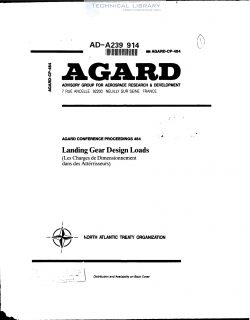AGARD-CP-484
- Version
- 450 Downloads
- 10.44 MB File Size
- 1 File Count
- May 10, 2017 Create Date
- May 10, 2017 Last Updated
Advisory Group for Aerospace Research & Development - Landing Gear Design Loads

Despite the extensive landing gear design analyses and tests carried out
by the designers and manufacturers, and the large number of trouble—free landings
accumulated by the users, the Canadian Forces, as well as others, have experienced
a range of problems or failures with landing gear components. Different data
banks were surveyed and over 200 case histories on more than 20 aircraft types
were reviewed in order to assess trends in failure mechanisms and their causes.
Fatigue and corrosion were found to be the main mechanisms. Fatigue
occurred mainly in steel components while corrosion occurred mainly with aluminium
alloy components and wheels. Very few overload failures were noted. Different
failure causes were identified. Design deficiencies and manufacturing defects
led mainly to fatigue failures while poor material selection and improper field
maintenance were the principal origins of corrosion related failures. Hence, a
series of preventive measures was either recommended or re—emphasized. while
fatigue can best be addressed by improving the quality of manufacturing and by
better characterizing in-service and manufacturing stresses, much work remains
to be done on the time-dependant degradation processes and their synergism with
fatigue, as corrosion has often been neglected in both the design and testing
stages as well as in the maintenance domain.
Landing gears are designed to provide aircraft support and control when
on the ground (steering and stopping) and to provide a rethod of absorbing the
loads and ctr;_;;; associated with lon:i;; :z‘ taxiing. Since they are not used
in flight, landing gear components have traditionally been designed to meet design
limit loads using high strength—to—weight materials in order to carry out their
functions with minimum weight and use of space. From a design viewpoint, landing
gear service life is assumed to be principally limited by fatigue considerations,
the time-dependent degradation of the materials being addressed only by means of
prevention.
Despite the extensive landing gear design analyses and tests carried out
by the designers and manufacturers, and the large number of trouble—free landings
accumulated by the users, the Canadian Forces (CF), as well as others, have
experienced a range of problems or failures with landing gear systems. This paper
provides an overview of the structural component failures as experienced by the
CF within the last two decades on more than 20 different aircraft. Table 1
describes the fleet and provides information on the number of landings, which
range from 200 to 1,200 per year per aircraft; this information is not recorded
for helicopters.
| File | Action |
|---|---|
| AGARD-CP-484 Landing Gear Design Loads.pdf | Download |

Comment On This Post